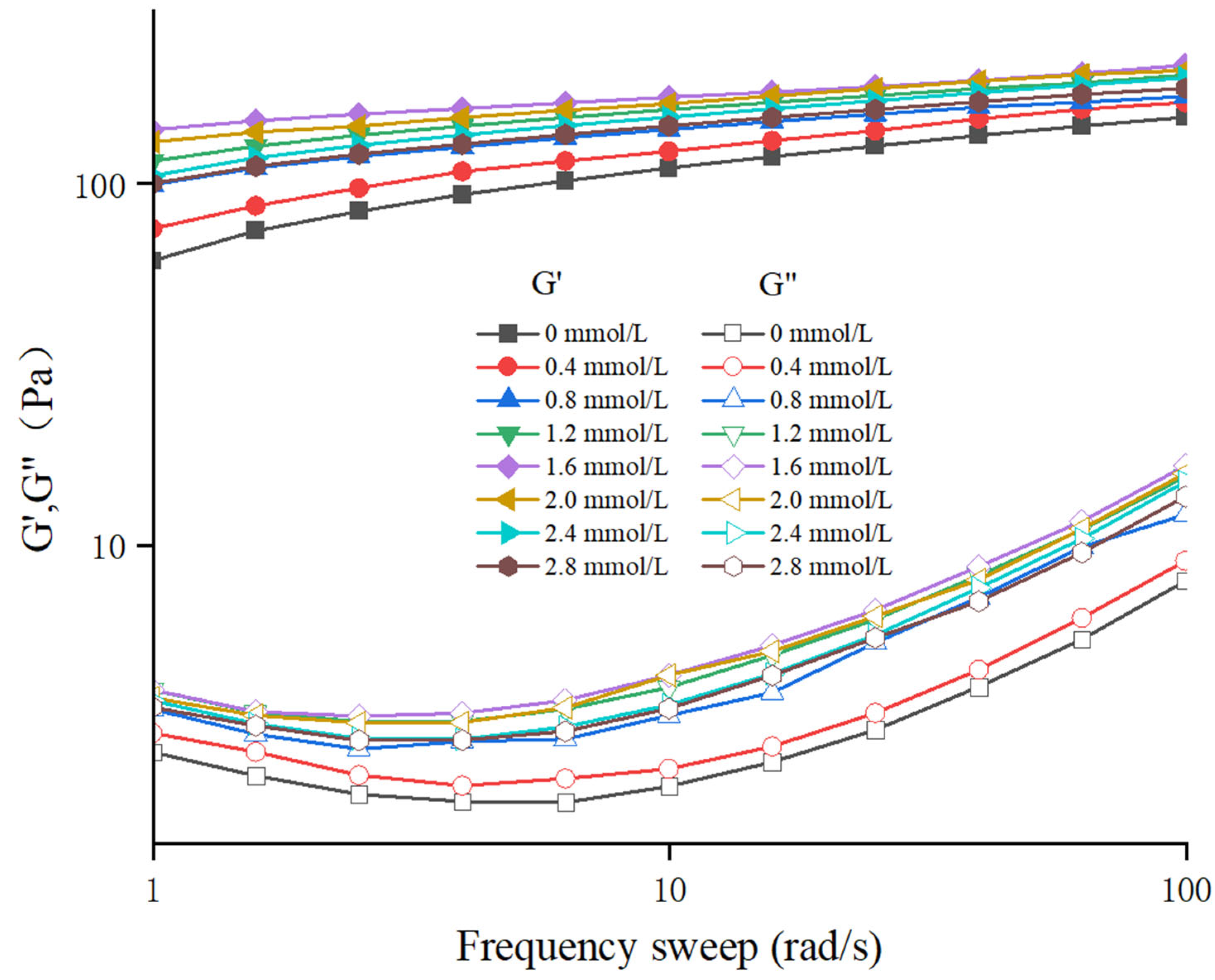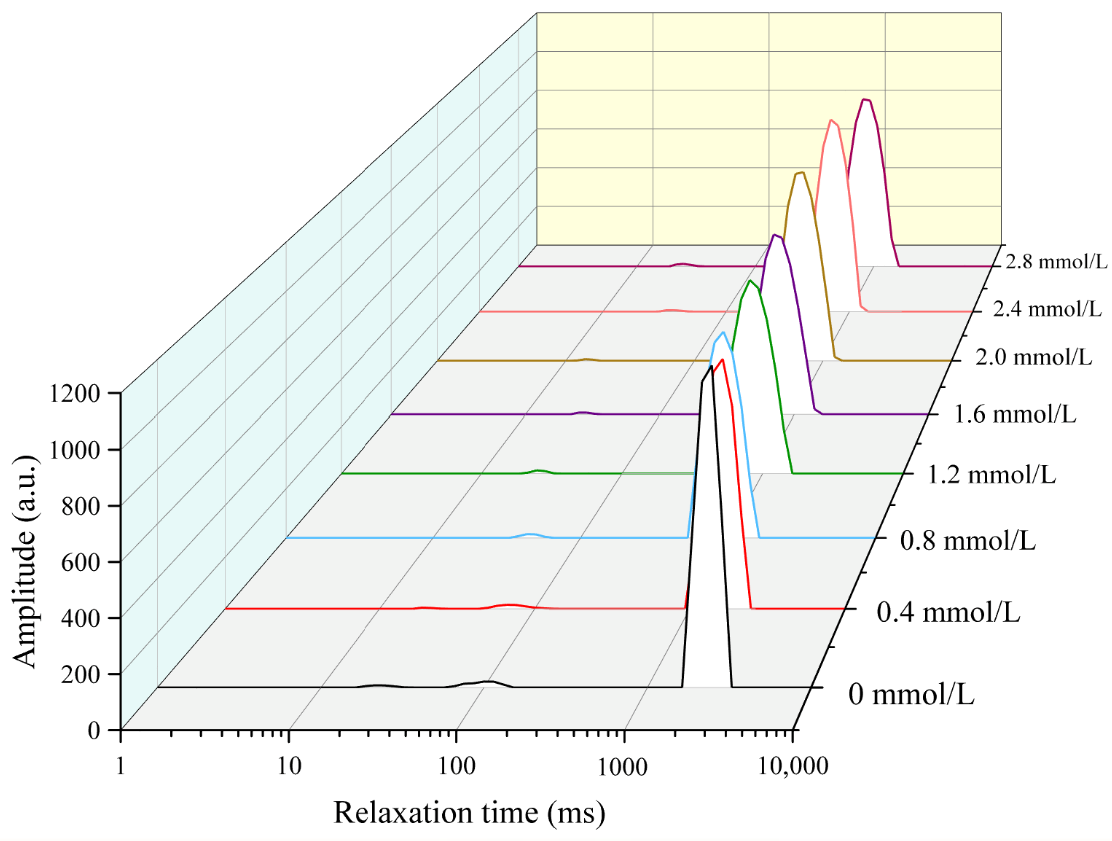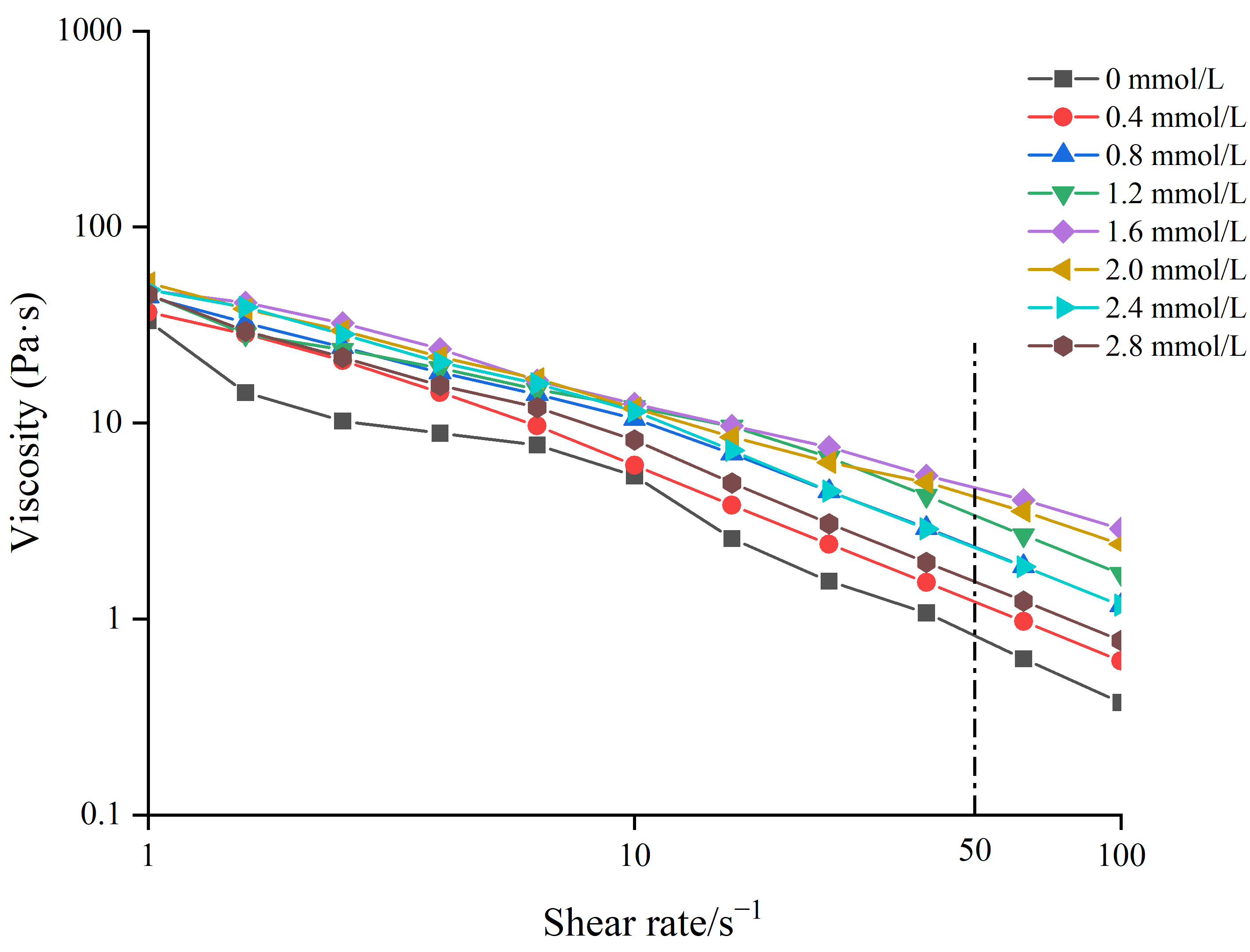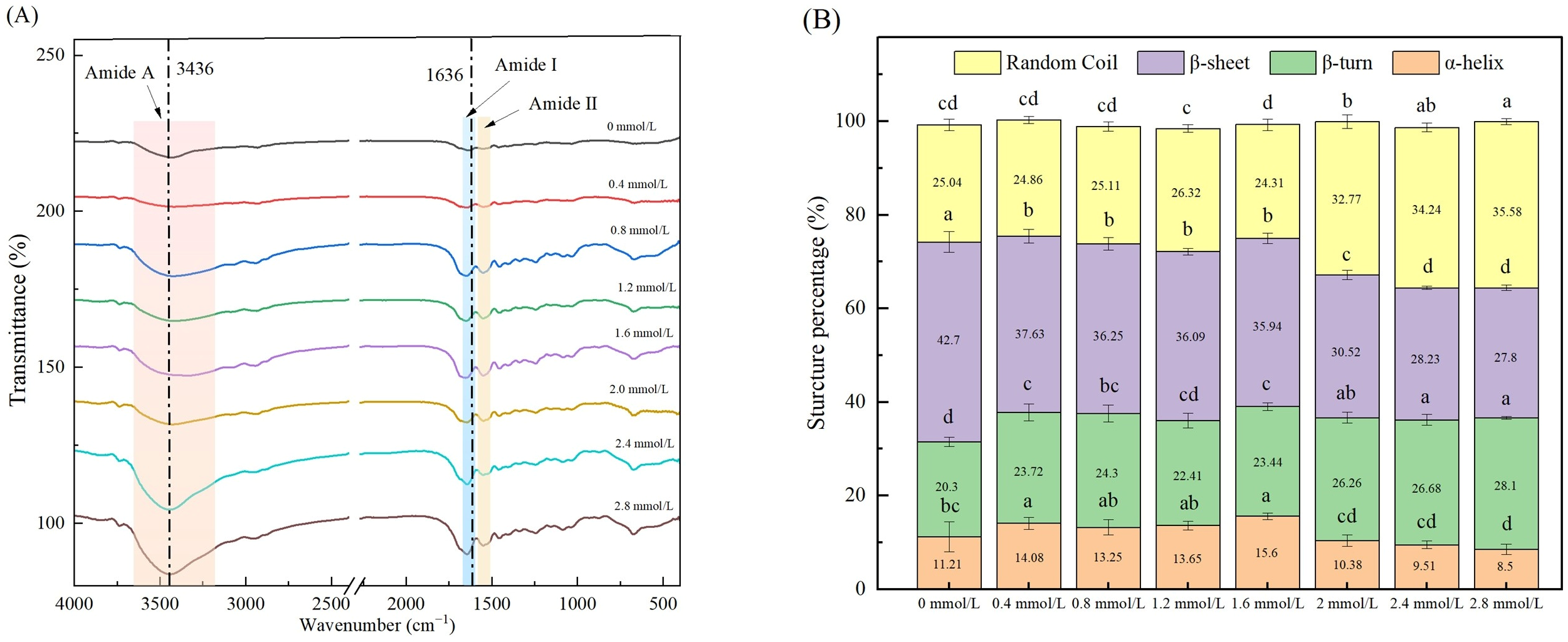Effects of Sodium Hexametaphosphate on the Gel Properties and Structure of Glutaminase-Transaminase-Crosslinked Gelatin Gels
Abstract
1. Introduction
2. Materials and Methods
2.1. Materials
2.2. Composite Gelatin Gel Preparation
2.3. Determination of Water Distribution
2.4. Texture Profile Analysis (TPA)
2.5. Rheological Properties Analysis
2.5.1. Apparent Viscosity
2.5.2. Frequency Sweep
2.6. Intrinsic Fluorescence Spectra
2.7. Fourier Transform Infrared Spectroscopy (FTIR)
2.8. Scanning Electron Microscopy (SEM)
2.9. Statistical Analysis
3. Results and Discussion
3.1. Analysis of Water Distribution
3.2. Texture Analysis
3.3. Apparent Viscosity Analysis
3.4. Frequency Sweep Analysis


3.5. Intrinsic Fluorescence Spectroscopy Analysis
3.6. FTIR
3.7. SEM Analysis
4. Conclusions
Author Contributions
Funding
Institutional Review Board Statement
Informed Consent Statement
Data Availability Statement
Conflicts of Interest
References
- Cui, X.; Lee, J.J.; Chen, W.N. Eco-friendly and biodegradable cellulose hydrogels produced from low cost okara: Towards non-toxic flexible electronics. Sci. Rep. 2019, 9, 18166. [Google Scholar] [CrossRef] [PubMed]
- Craciun, A.M.; Tartau, L.M.; Pinteala, M.; Marin, L. Nitrosalicyl-imine-chitosan hydrogels based drug delivery systems for long term sustained release in local therapy. J. Colloid Interface Sci. 2019, 536, 196–207. [Google Scholar] [CrossRef] [PubMed]
- Hsu, L.C.; Peng, B.Y.; Chen, M.S.; Thalib, B.; Ruslin, M.; Tung, T.D.X.; Chou, H.; Ou, K. The potential of the stem cells composite hydrogel wound dressings for promoting wound healing and skin regeneration: In vitro and in vivo evaluation. J. Biomed. Mater. Res. Part B Appl. Biomater. 2019, 107, 278–285. [Google Scholar] [CrossRef]
- Notodihardjo, S.C.; Morimoto, N.; Kakudo, N.; Mitsui, T.; Le, T.M.; Tabata, Y.; Kusumoto, K. Efficacy of gelatin hydrogel impregnated with concentrated platelet lysate in murine wound healing. J. Surg. Res. 2019, 234, 190–201. [Google Scholar] [CrossRef]
- Guo, T.; Zhang, N.; Huang, J.; Pei, Y.; Wang, F.; Tang, K. A facile fabrication of core–shell sodium alginate/gelatin beads for drug delivery systems. Polym. Bull. 2019, 76, 87–102. [Google Scholar] [CrossRef]
- Zhang, W.; Li, M.; Chen, J.; Chen, Y.; Liu, C.; Wu, X. A Review of Modified Gelatin: Physicochemical Properties, Modification Methods, and Applications in the Food Field. J. Agric. Food Chem. 2024, 72, 20705–20721. [Google Scholar] [CrossRef]
- Li, C.-P.; Enomoto, H.; Hayashi, Y.; Zhao, H.; Aoki, T. Recent advances in phosphorylation of food proteins: A review. LWT 2010, 43, 295–300. [Google Scholar] [CrossRef]
- Miedzianka, J.; Pęksa, A.J.F.C. Effect of pH on phosphorylation of potato protein isolate. Food Chem. 2013, 138, 2321–2326. [Google Scholar] [CrossRef] [PubMed]
- Felts, J.M.; Bucks, D.A.J.B. Selective release of extrahepatic lipoprotein lipase by polymetaphosphate. Biochem. Biophys. Res. Commun. 1981, 102, 1034–1040. [Google Scholar] [CrossRef]
- De Kort, E.; Minor, M.; Snoeren, T.; Van Hooijdonk, T.; Van Der Linden, E. Calcium-binding capacity of organic and inorganic ortho-and polyphosphates. Dairy Sci. Technol. 2009, 89, 283–299. [Google Scholar] [CrossRef]
- Shinde, A.P.; Meena, G.S.; Handge, J.U. Effect of sodium triphosphate and sodium hexametaphosphate on properties of buffalo milk protein concentrate 60 (BMPC60) powder. J. Food Sci. Technol. 2021, 58, 1996–2006. [Google Scholar] [CrossRef] [PubMed]
- Akbari, M.; Razavi, S.H.; Kieliszek, M. Recent advances in microbial transglutaminase biosynthesis and its application in the food industry. Trends Food Sci. Technol. 2021, 110, 458–469. [Google Scholar] [CrossRef]
- Chen, H.; Lan, X.; Zhang, Q.; Liu, H.; Ren, H.; Du, M.; Tang, J. Improving the comprehensive properties of gelatin films by transglutaminase and chitosan. Food Hydrocoll. 2024, 151, 109854. [Google Scholar] [CrossRef]
- Huang, T.; Tu, Z.-C.; Wang, H.; Liu, W.; Zhang, L.; Zhang, Y.; ShangGuan, X.-C. Comparison of rheological behaviors and nanostructure of bighead carp scales gelatin modified by different modification methods. J. Food Sci. Technol. 2017, 54, 1256–1265. [Google Scholar] [CrossRef]
- Yang, Z.; Hemar, Y.; Hilliou, L.; Gilbert, E.P.; McGillivray, D.J.; Williams, M.A.K.; Chaieb, S. Nonlinear behavior of gelatin networks reveals a hierarchical structure. Biomacromolecules 2016, 17, 590–600. [Google Scholar] [CrossRef] [PubMed]
- Cen, S.; Zhang, L.; Liu, L.; Lou, Q.; Wang, C.; Huang, T. Phosphorylation modification on functional and structural properties of fish gelatin: The effects of phosphate contents. Food Chem. 2022, 380, 132209. [Google Scholar] [CrossRef]
- Cheng, X.; Li, W.; Peng, R.; Chen, Y.; Mu, S.; Cui, L.; Liu, Z.; Wang, H.; Xu, J.; Jiang, L. Insight into the Stabilization Mechanism of Succinylation Modification on Black Bean Protein Gels: Molecular Conformation, Microstructure, and Gel Properties. J. Agric. Food Chem. 2024, 72, 15920–15932. [Google Scholar] [CrossRef]
- Yan, W.; Jia, X.; Zhang, Q.; Chen, H.; Zhu, Q.; Yin, L. Interpenetrating polymer network hydrogels of soy protein isolate and sugar beet pectin as a potential carrier for probiotics. Food Hydrocoll. 2021, 113, 106453. [Google Scholar] [CrossRef]
- Tian, Y.; Wang, S.; Li, T.; Lv, J.; Zhang, X.; Oh, D.; Fu, X. Effect of transglutaminase on ovalbumin emulsion gels as carriers of encapsulated probiotic bacteria. J. Sci. Food Agric. 2024, 104, 3468–3476. [Google Scholar] [CrossRef]
- Chen, Y.S.; Li, Y.; Yang, X.X.; Cao, Z.; Nie, H.; Bian, Y.; Yang, G. Glucose-triggered in situ forming keratin hydrogel for the treatment of diabetic wounds. Acta Biomater. 2021, 125, 208–218. [Google Scholar] [CrossRef]
- Liu, Y.; Cai, Z.; Sheng, L.; Ma, M.; Xu, Q.; Jin, Y. Structure-property of crosslinked chitosan/silica composite films modified by genipin and glutaraldehyde under alkaline conditions. Carbohydr. Polym. 2019, 215, 348–357. [Google Scholar] [CrossRef] [PubMed]
- Hu, B.; Cen, S.; Sun, W.; Zhan, S.; Jia, R.; Ou, C.; Huang, T. Effects of different phosphorylation times and pH on fish gelatin: Functional properties, structural and mechanism analysis. Food Hydrocoll. 2024, 152, 109876. [Google Scholar] [CrossRef]
- Zhang, Z.; Yang, Y.; Zhou, P.; Zhang, X.; Wang, J. Effects of high pressure modification on conformation and gelation properties of myofibrillar protein. Food Chem. 2017, 217, 678–686. [Google Scholar] [CrossRef] [PubMed]
- Zhang, K.; Li, Y.; Ren, Y. Research on the phosphorylation of soy protein isolate with sodium tripoly phosphate. J. Food Eng. 2007, 79, 1233–1237. [Google Scholar] [CrossRef]
- Zou, P.-R.; Hu, F.; Ni, Z.-J.; Zhang, F.; Thakur, K.; Zhang, J.-G.; Wei, Z.-J. Effects of phosphorylation pretreatment and subsequent transglutaminase cross-linking on physicochemical, structural, and gel properties of wheat gluten. Food Chem. 2022, 392, 133296. [Google Scholar] [CrossRef]
- Huang, T.; Tu, Z.-C.; Shangguan, X.; Wang, H.; Sha, X.; Bansal, N. Rheological behavior, emulsifying properties and structural characterization of phosphorylated fish gelatin. Food Chem. 2018, 246, 428–436. [Google Scholar] [CrossRef]
- Jurášková, D.; Ribeiro, S.C.; Silva, C.C.G. Exopolysaccharides produced by lactic acid bacteria: From biosynthesis to health-promoting properties. Foods 2022, 11, 156. [Google Scholar] [CrossRef]
- Liu, P.; Xu, H.; Zhao, Y.; Yang, Y. Rheological properties of soy protein isolate solution for fibers and films. Food Hydrocoll. 2017, 64, 149–156. [Google Scholar] [CrossRef]
- Biglarian, N.; Rafe, A.; Shahidi, S.A.; Lorenzo, J.M. Rheological, textural and structural properties of dairy cream as affected by some natural stabilizers. Chem. Biol. Technol. Agric. 2022, 9, 96. [Google Scholar] [CrossRef]
- Gornall, J.L.; Terentjev, E.M. Helix–coil transition of gelatin: Helical morphology and stability. Soft Matter 2008, 4, 544–549. [Google Scholar] [CrossRef]
- Wang, Y.; Liu, A.; Ye, R.; Wang, W.; Li, X. Transglutaminase-induced crosslinking of gelatin–calcium carbonate composite films. Food Chem. 2015, 166, 414–422. [Google Scholar] [CrossRef] [PubMed]
- Ma, X.; Chen, W.; Yan, T.; Wang, D.; Hou, F.; Miao, S.; Liu, D. Comparison of citrus pectin and apple pectin in conjugation with soy protein isolate (SPI) under controlled dry-heating conditions. Food Chem. 2020, 309, 125501. [Google Scholar] [CrossRef] [PubMed]
- Sow, L.C.; Kong, K.; Yang, H. Structural modification of fish gelatin by the addition of gellan, κ-carrageenan, and salts mimics the critical physicochemical properties of pork gelatin. J. Food Sci. 2018, 83, 1280–1291. [Google Scholar] [CrossRef] [PubMed]
- Li, L.; Zhang, Q.; Yuan, X.; Yang, H.; Qin, S.; Hong, L.; Pu, L.; Li, L.; Zhang, P.; Zhang, J. Study of the molecular structure of proteins in fermented Maize-Soybean meal-based rations based on FTIR spectroscopy. Food Chem. 2024, 441, 138310. [Google Scholar] [CrossRef]
- Wang, K.-Q.; Luo, S.-Z.; Zhong, X.-Y.; Cai, J.; Jiang, S.-T.; Zheng, Z. Changes in chemical interactions and protein conformation during heat-induced wheat gluten gel formation. Food Chem. 2017, 214, 393–399. [Google Scholar] [CrossRef]
- Sun, W.; Zhou, G.; Xu, X.; Peng, Z. Studies on the structure and oxidation properties of extracted cooked cured meat pigment by four spectra. Food Chem. 2009, 115, 596–601. [Google Scholar] [CrossRef]





| SHMP/mmol·L−1 | Hardness (g) | Springiness | Cohesiveness | Gelatinous | Chewiness | Resilience |
|---|---|---|---|---|---|---|
| 0 | 215.382 ± 7.313 c | 0.960 ± 0.018 a | 0.913 ± 0.009 a | 194.154 ± 10.080 c | 308.788 ± 3.872 d | 0.775 ± 0.010 a |
| 0.4 | 252.981 ± 11.283 b | 0.963 ± 0.024 a | 0.907 ± 0.013 a | 218.869 ± 1.217 b | 347.248 ± 6.210 b | 0.780 ± 0.001 a |
| 0.8 | 260.655 ± 5.304 b | 0.964 ± 0.008 a | 0.905 ± 0.007 a | 220.547 ± 1.447 b | 349.897 ± 3.285 b | 0.785 ± 0.144 a |
| 1.2 | 302.969 ± 18.449 a | 0.970 ± 0.007 a | 0.909 ± 0.006 a | 236.068 ± 7.020 a | 362.377 ± 13.135 a | 0.789 ± 0.008 a |
| 1.6 | 304.258 ± 11.167 a | 0.965 ± 0.025 a | 0.909 ± 0.007 a | 240.287 ± 6.681 a | 366.916 ± 5.681 a | 0.783 ± 0.007 a |
| 2.0 | 299.601 ± 5.150 a | 0.970 ± 0.017 a | 0.919 ± 0.009 a | 234.701 ± 4.796 a | 362.991 ± 8.137 a | 0.772 ± 0.004 a |
| 2.4 | 247.144 ± 16.343 b | 0.965 ± 0.119 a | 0.915 ± 0.006 a | 215.880 ± 10.669 b | 330.297 ± 8.152 c | 0.782 ± 0.006 a |
| 2.8 | 205.945 ± 10.304 c | 0.968 ± 0.183 a | 0.916 ± 0.009 a | 193.291 ± 8.756 c | 300.391 ± 7.706 d | 0.776 ± 0.214 a |
| SHP Concentrations (mmol/L) | 0 | 0.4 | 0.8 | 1.2 | 1.6 | 2.0 | 2.4 | 2.8 |
|---|---|---|---|---|---|---|---|---|
| Pore size (μm) | 54.0 ± 1.87 a | 51.4 ± 1.94 b | 51.2 ± 1.3 b | 48.4 ± 1.14 d | 31.2 ± 1.09 e | 47.8 ± 1.64 d | 50.4 ± 1.67 bc | 48.8 ± 1.92 cd |
Disclaimer/Publisher’s Note: The statements, opinions and data contained in all publications are solely those of the individual author(s) and contributor(s) and not of MDPI and/or the editor(s). MDPI and/or the editor(s) disclaim responsibility for any injury to people or property resulting from any ideas, methods, instructions or products referred to in the content. |
© 2025 by the authors. Licensee MDPI, Basel, Switzerland. This article is an open access article distributed under the terms and conditions of the Creative Commons Attribution (CC BY) license (https://creativecommons.org/licenses/by/4.0/).
Share and Cite
Chen, J.; Ding, X.; Cao, W.; Wei, X.; Jin, X.; Chang, Q.; Li, Y.; Li, L.; Liu, W.; Yang, T.; et al. Effects of Sodium Hexametaphosphate on the Gel Properties and Structure of Glutaminase-Transaminase-Crosslinked Gelatin Gels. Foods 2025, 14, 2175. https://doi.org/10.3390/foods14132175
Chen J, Ding X, Cao W, Wei X, Jin X, Chang Q, Li Y, Li L, Liu W, Yang T, et al. Effects of Sodium Hexametaphosphate on the Gel Properties and Structure of Glutaminase-Transaminase-Crosslinked Gelatin Gels. Foods. 2025; 14(13):2175. https://doi.org/10.3390/foods14132175
Chicago/Turabian StyleChen, Junliang, Xia Ding, Weiwei Cao, Xinyu Wei, Xin Jin, Qing Chang, Yiming Li, Linlin Li, Wenchao Liu, Tongxiang Yang, and et al. 2025. "Effects of Sodium Hexametaphosphate on the Gel Properties and Structure of Glutaminase-Transaminase-Crosslinked Gelatin Gels" Foods 14, no. 13: 2175. https://doi.org/10.3390/foods14132175
APA StyleChen, J., Ding, X., Cao, W., Wei, X., Jin, X., Chang, Q., Li, Y., Li, L., Liu, W., Yang, T., Duan, X., & Ren, G. (2025). Effects of Sodium Hexametaphosphate on the Gel Properties and Structure of Glutaminase-Transaminase-Crosslinked Gelatin Gels. Foods, 14(13), 2175. https://doi.org/10.3390/foods14132175





